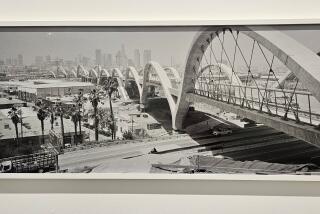Long-buried photos at the Geffen Contemporary resurrect L.A. punk’s primal days
For a few years starting in the early 1980s, two artists, Brian Tucker and Nikki Tucker, distributed their photo-zine, FER YOUz, anywhere that Los Angeles punk rockers were gathering.
The scene was still in its infancy, and the Tuckers, then in their mid-20s, had become fascinated with how the movement was evolving. Nikki had studied art history at UCLA, and both understood that the culture was ripe for a project. So they started taking photos, arranging them as collages and printing and handing out the tabloids as a way of giving back to an underground community of misfits looking for direction and inspiration.
The Tuckers, who are now married, ended up publishing 16 issues of FER YOUz. Photos from those collage-heavy black-and-white tipsheets, as well as punk fliers from the artists’ voluminous archives, are on display starting Thursday as part of the Los Angeles Art Book Fair at the Geffen Contemporary at MOCA.
Much of the Tuckers’ photography has never been publicly shown, and it shines new light on a seminal moment in L.A. music culture. Among the bounty are rarely seen photos of Black Flag, the Circle Jerks, Fear, Bad Brains and others.
In addition to displaying highlights from their collection of more than 2,500 punk fliers, the Tuckers will be offering a limited-edition folio of 100 prints from the FER YOUz archives. Published by Arthur Fournier Fine & Rare Books, the folio reveals hidden corners and lost souls of L.A. punk. As well, the publication is the first of what Fournier and the Tuckers hope will be an ongoing process of reintroducing the work.
On Wednesday, the Tuckers took time away from hanging the art book fair show to talk about the work. Below are excerpts from the conversation, coupled with photos from the folio, as well as a statement on the Tuckers’ activity from former Black Flag and Circle Jerks singer Keith Morris.
On Saturday, the Tuckers, Fournier, Morris and others will gather at 2 p.m. for a free public talk at the Geffen.
Nikki Tucker: The first [issue] we might have handed out at a gig. People didn’t know what it was. The second one, more people had seen them and wanted them. By the time I handed out that third one -- we started handing them out at Oki Dogs, across from Astro Burgers -- I started walking up with it and “boom,” I just became surrounded by people. It went from “What’s this?” to “This is kinda cool” to “Oh, I gotta have one.” Then it became, people were waiting. You could tell people were waiting to see me bringing this from the car.
Brian Tucker: Taking photos of people who didn’t have money. Not that we had money, because we didn’t either, but we had enough where we could buy film and take photos. We had this thing where we’re stealing their image. We’re taking photos of people that can’t own these themselves. Out of that we were like, “We can give it back to them.” The way you give it back to them is in this poster form. It’s cheap enough, we could afford a hundred of them, maybe 150. I had a guy at a copy place -- a Deadhead -- who was cool and would say, “I snuck in an extra 50 copies.”
NT: “When I was at UCLA, I was studying African art history. I did my bachelor’s and then I started a graduate program for two years. [But] I had to make a decision, so I dove out of the ivory tower onto the cement.
My professor, Arnold Rubin, was not only studying African art, but he was very interested in subcultural things. He and other professors studied the Rose Bowl Parade almost like it was African art -- documented that in the ‘60s. Brian and I had always liked live music. We had gone to the Ash Grove and seen every cool black blues band you could possibly think of when we were in our teens. We were already live music people that way.”
BT: “When they got that, they were like, “... Here we are! We exist!” That’s why we kept it free. No charge. We already owned the images, so you don’t charge them back. And by doing that, everybody was getting us into shows free. Before that, we would have to juggle -- do we buy film and go in? We gotta be able to process it. There was a lot we couldn’t do. Once we didn’t have to pay to get in, that really benefited us to just keep pumping the film.”
NT: I think we totally understood [punk], but I’ve been thinking about this and I think they didn’t want us to be punks, in a way. After a while, we were like “Mom and Dad punk rock.” We were on average 10 years older. A lot of crazy stuff happened out there. There were a lot of throwaway kids. “Where are your parents?” “I think they’re in Europe.” We started being kind of like this adult presence. We would help people. If someone would get hurt we’d take them to the hospital. Make sure kids were protected.
BT: I don’t want to say we weren’t punks. I was an angry guy. She was angry and she didn’t know it. (Nikki’s version: “I had a psychopath dad that I didn’t realize was a psychopath yet.”) You don’t hang around someplace that you don’t really “get.” It was smart anarchy. We didn’t have to do anything that was going to hurt us.
BT: We got really lucky using the Kodachrome 64 [film] and, in combination with the camera and the flash, that made for some beautiful images. The color was stunning. I remember the guys in the camera store going, “Holy moley.” They couldn’t believe how good the saturation was on a flash. The combination seemed to be working, and then you have Kodachrome, which is the most stable film. It was luck. They look like they were shot yesterday.
We dirtied up the images. We didn’t want a clean image. That’s not punk rock. So if you printed it super clean, the image is really nice, almost tabloid. By getting it on color Xerox first, the Xerox machine gets it high-contrasty, and then you send it through this old Canon copier to get the black and white and they get even grittier. We’d have a perfectly clean image on the original, and then you dirty it down over three or four steps. You had to punk it up.
At the beginning, said Nikki, the scene was inspired by British punk. “They had jeans with the bondage straps.” But, added Brian: “There was also already that Huntington Beach thing with the Pendletons. And there was the stripped-down hard core with the T-shirt, pair of pants, suspenders -- almost no fashion.”
NT: When Fear played, we started to get it. At first it was like, “What the hell is going on here?” In fact, when we left it was like the burning of Saigon. You felt like you were going to walk outside and the city was going to be on fire.
I’m taking notes because Arnold Rubin is saying, “You’ve got to document this!” I had learned from him the field work methodology, the same you would do in Africa. How does the music, dance, body aesthetic -- the whole framework of expression -- get integrated? “What you wear is a marker of who you are as a society,” and all that. That methodology was perfect for looking at this intensely. It wasn’t just, “Let’s take pictures of our favorite bands. Let’s take pictures of people’s hair, their tattoos, their jewelry.” That gave us that idea to record everything.
Keith Morris, current screamer for Off! and former member of Black Flag and Circle Jerks, said in a statement: “Nikki and Brian’s photography captured a very important segment of Southern California’s musical history and the truly amazing part of their situation was that they moved through all of this so freely! He and she’d infiltrated the ranks and were part of everybody’s family, gang or crew and owned an open ended invitation to all of our punk rock fiestas.”
Morris added that he considers the Tuckers’ work to be “on the same plateau” as more celebrated punk chroniclers including “Ed Colver, Jenny Lens, Glen E. Friedman, Anna Summa, Mouse Braun, Gary Leonard, the photographers on the staff at Slash, Flipside, No, We Got Power, Back Door Man and Damage magazines and fanzines. The Tuckers are STUD RAWK CHAMPIONS!’’
BT: Because this wasn’t about favorites, everything came in. Whether it was first-wave England [punk], second-wave England, whether it was Oxnard or San Francisco or D.C. -- you document it. You have 10 different versions of what you think is cool and punk rock, but that wasn’t separated here. We weren’t documenting the specifics. It was, everything that happened that month is taken into consideration whether you like it or not.
You make a FER YOUz poster and kids would burn people’s faces out with a cigarette because “that guy’s a ...” Rubin’s methodology of not editing and shooting everything -- history will determine whatever, but you don’t edit first -- that’s why this is thorough in all the scenes within this big scene.
NT: We had free access into everything, and you’ll notice that there’s only maybe three or five band pictures [in each issue] and everything else is just kids. So it got to be where you were in a band, you wanted to be in FER YOUz, and that’s when bands would drag you into the back room, through a hole in the wall in the back of Godzilla’s. Everybody wanted us in there.
Follow Randall Roberts on Instagram and Twitter: @liledit
More to Read
The biggest entertainment stories
Get our big stories about Hollywood, film, television, music, arts, culture and more right in your inbox as soon as they publish.
You may occasionally receive promotional content from the Los Angeles Times.







